Climate Change
CCWG staff have assisted local and regional partners in the development of climate mitigation and adaptation plans for the central coast. CCWG is focused on supporting adaptation planning through the collection of regional data and the coordination of adaptation planning among jurisdictions, regulatory authorities and resource managers. CCWG aims are to ensure that the wetland resource management is included as a goal when agencies begin to define infrastructure, resources and properties that are vulnerable to sea level rise and ensure that aquatic resource protection is accounted for as adaptation planning is carried out.
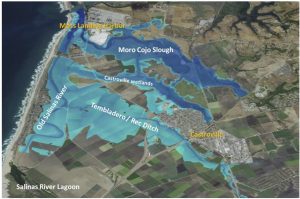
Adaptation, resiliency and habitat enhancement planning for predicted impacts of sea level rise and storm flooding on agriculture within the Salinas Valley
More than 8,000 acres of agricultural land within the lower Salinas Valley are vulnerable to the combined climate change hazards of sea level rise, increased fluvial discharges and coastal wave induced flooding. On December 11, 2014, localized rainfall within the Gabilan hills caused discharges of almost 700cfs within the Reclamation Ditch (Tembladero Slough). River flows increased during winter king tides, causing significant flooding of agriculture lands within the lower Salinas Valley. Flood damage was estimated at more than $2 million in crop losses. The future threats from increases in river flows during less frequent but more intense rain events were investigated within the Moss Landing Sea Level Rise Vulnerability Report (CCWG 2017). The report found that additional flooding impacts are projected by 2030 for the northern portion of Castroville, along with habitat and agricultural lands along the Old Salinas River and Tembladero Slough due to the added effects of rising seas which will overwhelm current flood management infrastructure.
Historical wetland areas along the Old Salinas River and Tembladero Slough between Moss Landing Harbor and Salinas remain in agriculture production through the aid of tide gates and stormwater lift stations that pump water out of the low-lying areas but remain vulnerable to flooding exacerbated by climate change. Through this project, theCentral Coast Wetlands Group (CCWG), in partnership with Coastal Conservation and Research (CCR), The Nature Conservancy (TNC), local landowners and the Greater Monterey County Integrated Regional Water Management Program, will support creek and floodplain restoration planning and design needed to implement projects that accommodate documented flooding hazards within these agricultural areas of the lower Salinas Valley (CCWG 2017).
This project will evaluate managed retreat options that can help farmers avoid future flood hazards while continuing to farm areas safe from flooding and support the design of two channel and floodplain restoration project to restore natural watershed processes to the Salinas Valley.
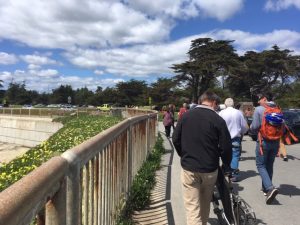
West Cliff Drive Adaptation & Management Plan
CCWG is working with Revell Coastal to support the City of Santa Cruz in developing a West Cliff Drive Adaptation and Management Plan. This project is funded by CalTrans, and will lead to implementation and development of adaptation projects and policies to address the impacts of climate change on the transportation network, as well as protect coastal recreation and access and preserve habitat.
Reports:
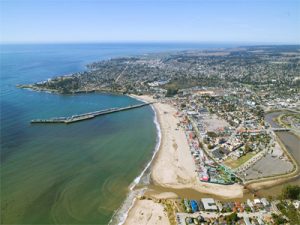
City of Santa Cruz LCP Strategies and Policies to Support Beach and Public Access Protection
Development of Sea Level Rise Strategies & Policies to Support Beach and Public Access Protection is a project funded by the California Coastal Commission that spans Seabright, Main, Cowell and Natural bridges beaches as well as the West Cliff pocket beaches in the City of Santa Cruz. The goal of this project is to provide the Santa Cruz community and decision makers with more comprehensive information and recommendations for programs, policies and actions that can achieve resilient coastal access, use and beach management and to integrate them into a Local Coastal Program (LCP) Update. The LCP is what gives the City authority to issue Coastal Development Permits that are aligned with the California Coastal Act.
CCWG Specific Tasks include:
- Conduct a climate adaptation policy implication and response strategy evaluation
- Assist in the design and implementation of an Outreach and Engagement Plan
- Develop LCP adaptation policy guidance
Reports:
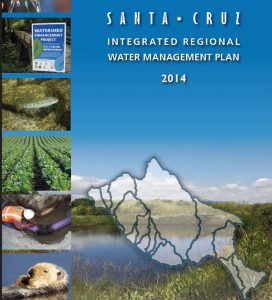
Santa Cruz IRWM Plan Update: Climate Change
CCWG is working with the Regional Water Management Foundation of Santa Cruz County to conduct a climate change vulnerability assessment and recommend climate change related planning efforts in support of updating the Santa Cruz IRWM Plan to meet the 2016 Proposition 1 IRWM Plan Standards. The IRWM Plan will address adaptation to the effects of climate change and mitigation of GHG emissions (Water Code §10541.(e)(10)). Due to the overarching aspects of climate change, adaptation and mitigation will be addressed in various individual IRWM Plan components, along with a general discussion of climate change.
- Link to report: Appendix B of the linked document

Moss Landing Harbor AB 691 Sea Level Rise Vulnerability Assessment
An assessment of the impact of sea level-rise on granted public trust lands, as described in the Resolution of the California Ocean Protection Council on Sea-level Rise and the latest version of the State of California Sea-Level Rise Guidance Document. This project will achieve four objectives (as defined by the State Lands Commission) intended to further regional planning for the inevitable impacts associated with predicted Sea Level Rise (SLR) on the Moss Landing Harbor, Elkhorn Slough and adjacent beach areas within the properties in and adjacent to the state lands granted to the Moss Landing Harbor District. Goals include:
- Identify what critical coastal infrastructure would be compromised due to predicted SLR for time horizons 2030, 2060, and 2100 and for extreme SLR scenarios (H++).
- Identify what critical coastal subtidal habitats would be compromised due to predicted SLR for time horizons 2030, 2060, and 2100 and for extreme SLR scenarios (H++).
- Identify appropriate response strategies for these risks and discuss the programmatic and policy options that can be adopted to address these risks.
- Quantify the potential financial losses of infrastructure within the predicted hazard zones and the costs of adaptation alternatives.

Evaluation of Sea Level Rise Impact Projections and Adaptation Strategies For an update to the City of Santa Cruz Hazard Mitigation Plan
This project will achieve three key objectives intended to further City of Santa Cruz planning for the likely impacts associated with sea-level rise (SLR): 1) Identify what critical coastal infrastructure (municipal, residential and commercial) will be vulnerable to SLR and estimate when those risks may occur; 2) Identify specific hazards (coastal flooding, sea level rise, erosion) that pose risks to various infrastructure, 3) Define appropriate strategies for these risks and work with City department staff to identify actions that can be integrated into the updated Hazard Mitigation Plan and Climate Adaptation Plan.
The project will compile an inventory of coastal armoring and water control structures to aid the prioritization (by city staff) of adaptation and protection upgrades for vulnerable infrastructure. The project team will provide the City GIS staff with updated hazard layers and provide technical instruction on the proper use these data for future City analysis and reporting.
The project will evaluate adaptation response alternatives for Santa Cruz ranging from “grey to green” for use in municipal planning documents. The project will support staff discussions regarding how to implement appropriate adaptation strategies through Local Coastal Program and other planning documents. The project team will present findings to department heads and/or City Council.
- Link to report on City of Santa Cruz wesite (when complete)
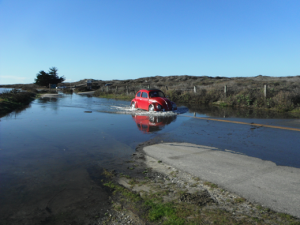
Collaborative Efforts to Assess SLR Impacts and Evaluate Policy Options for the Monterey Bay Coast
The goal of this project is to provide Santa Cruz and Monterey Counties with improved information regarding the threats from climate change to various coastal resources and land uses that best protect the multiple interests of the Counties and Cities; including municipal service districts, private land owners, the public’s access to the coast, and the protection of coastal ecosystems. This project will achieve three key objectives intended to further regional planning for the inevitable impacts associated with Sea Level Rise and the confounding effects of SLR on fluvial processes of two river systems.
- Identify what critical coastal infrastructure will be compromised due to SLR and estimate when those risks may occur.
- Identify how fluvial processes will increase flooding risk to coastal communities in the face of rising seas.
- Define appropriate response strategies for these risks and discuss with regional partners the programmatic and policy options that can be adopted to address these risks to the region.
Outreach:
Final Reports:
- Moss Landing
- City of Capitola
- Santa Cruz County
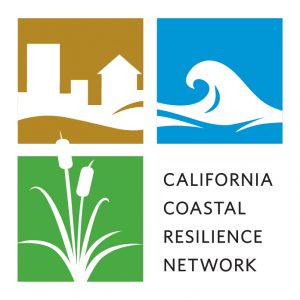
Coastal Resilience Network in Monterey
In collaboration with The Nature Conservancy (TNC), CCWG will act as the Geographic Lead Coordinator for the Coastal Resilience Network in Monterey. As a key participant in ongoing Sea Level Rise Adaptation Planning efforts around Monterey Bay, CCWG will act as liaison for the project, connecting TNC staff to the ongoing Monterey project’s stakeholders. CCWG will assist TNC in designing, coordinating, and hosting workshops, webinars and meetings, as appropriate, with the appropriate stakeholders in Monterey. These workshops will allow the stakeholders to react to and identify lessons learned from Monterey’s ongoing adaptation effort.
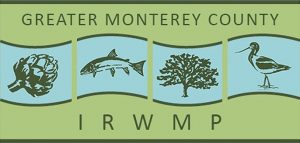
Greater Monterey County IRWM Plan- Climate Change Chapter
By design, IRWM planning efforts are collaborative and include many entities dealing with water management. These aspects make IRWM a good platform for addressing broad-based concerns like climate change, where multiple facets of water management are affected. The intent of the Climate Change standard in the Proposition 84/1E IRWM Program Guidelines is to ensure that IRWM Plans describe, consider, and address the effects of climate change on their regions and disclose, consider, and reduce when possible greenhouse gas (GHG) emissions when developing and implementing projects. CCWG took the lead in writing the Climate Change Chapter for the Greater Monterey County IRWM Plan. The chapter describes global climate change and its anticipated impacts for the Greater Monterey County region, including an initial vulnerability analysis and risk assessment, and offers preliminary adaptation measures and climate change mitigation and GHG reduction strategies for the planning region. These strategies will be refined as more climate change data, and more refined analysis tools, become available.
2017 Update: CCWG is tasked with updating the Climate Change Chapter within the Greater Monterey County Integrated Regional Water Management (IRWM) Plan – an existing IRWM Plan – to comply with the IRWM 2016 Plan Standards. The end result of the work will be an adopted IRWM Plan that meets the IRWM Plan Standards as detailed in Volume 2, Section II of the 2016 IRWM Guidelines.
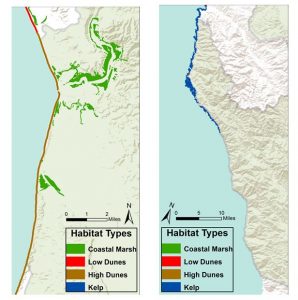
Incorporating Natural Infrastructure into Regional Climate Adaptation Planning
CCWG collaborated with Stanford, Center for Ocean Solutions, ESA PWA and the County of Santa Cruz to study the role of natural infrastructure in climate adaptation planning. An interdisciplinary team of scientists, economists, engineers, and law and policy experts and planners used an iterative engagement process to (1) identify natural infrastructure that is geographically relevant to local jurisdictional planning units, (2) refine data and models to reflect regional processes, and (3) develop metrics likely to resonate within the local decision contexts. Using an open source decision- support tool (InVEST), the group demonstrated that protecting existing natural infrastructure, including coastal dunes and wetlands, could reduce the vulnerability of water resource-related structures, coastal populations, and farmland most exposed to coastal flooding and erosion. This information formed part of the rationale for priority climate adaptation projects the county governments are now pursuing.

